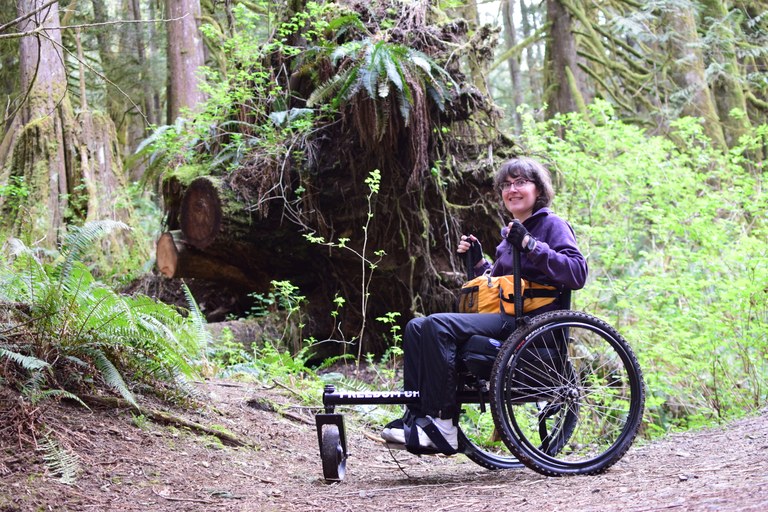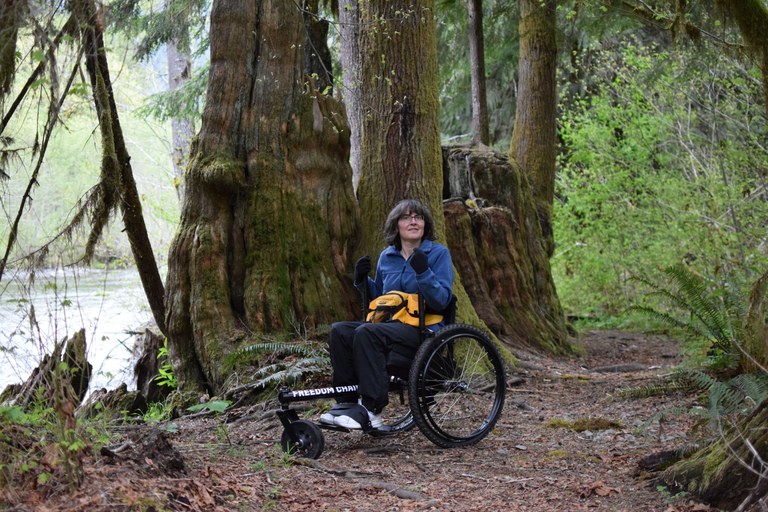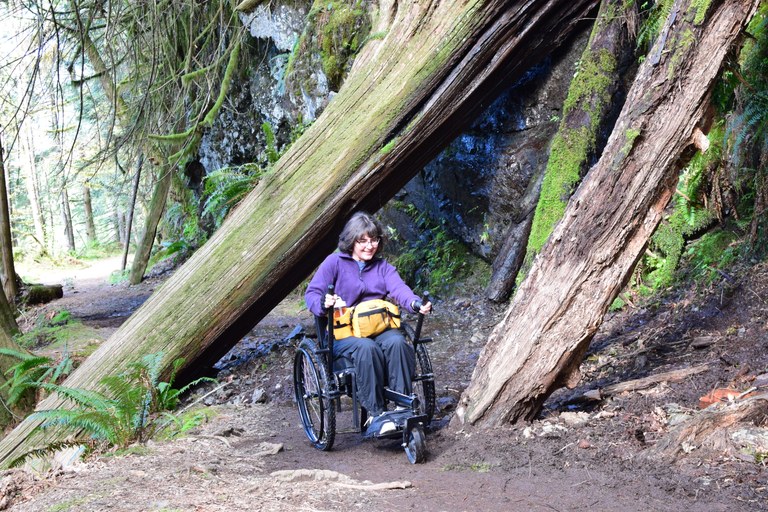 Washington Trails
Association
Washington Trails
Association
Trails for everyone, forever
How I kept hiking, backpacking and exploring the wild places I love, with the assistance of a wheelchair | by Jenny Schmitz
When I first moved to Seattle in 2002, my husband and I were elated by the mountains and wilderness to explore. Within a few months, however, my 9-year coexistence with a neurodegenerative disease (MS) changed from pesky diagnosis to traumatic reality, and I progressed through a parade of assistive devices: cane, crutch, two crutches, wheelchair. Hiking the Wonderland Trail moved from goal to dream.
With the loss of mobility comes the loss of identity. How do you answer the question, “Do you like to backpack?” if your legs no longer work?
Eventually, I came to terms with my new reality and set about creating an identity that incorporated my lifelong love of wilderness, tempered by realism. As walking became more difficult, I learned to do everything sitting down. Eventually, I figured out how to apply this to hiking as well, starting with a change in perspective: the wheelchair as an assistive device rather than as a symbol of disability.
The main prohibitive factor was the front caster wheels. They would get stuck on every rock or root and become mired in the soft surfaces of sand, dirt, mud, grass and gravel. For me, the problem was finally solved with a FreeWheel — a third wheel that sticks out in front of the wheelchair, lifting the casters off of the ground. With the addition of this accessory, I was able to race down the cobblestones of Italy and over the volcanic ash trails of Iceland.

I continued searching for the ultimate trail wheelchair. I considered several options, but they were too expensive or otherwise inappropriate for me. My trail chair of choice is currently the GRIT Freedom Chair, an all-terrain wheelchair complete with a third wheel, thick and knobby mountain-bike tires and levers for efficient propulsion.
The second obstacle is the trails. Most trails are simply not appropriate for wheelchairs. With mountain-bike tires, I am able to go beyond paved ADA-accessible trails. With the third wheel, I can manage many rocks, roots and soft surfaces. With push levers, I can go significant distances. With strong arms and assistance from an enthusiastic, able-bodied husband, I can even manage short ups and downs. However, I can’t do anything about trails that are narrow or have steps. Also, Washington’s mountainous geography creates many off-limits areas for most of us in wheelchairs. In addition, continuous rocks or roots usually mean an unenjoyable experience. Adventurous, physically fit youth may thrill at the challenge of tackling less wheelchair-friendly trails, but I have grown weary of turning back when the trail becomes impassable. The best way to avoid these obstacles seems to be the cautious approach of choosing an appropriate trail through recommendations.
When I first started wheelchair hiking, I searched for information on wheelchair trails. I found what seemed to be the perfect book, entitled “Accessible Trails in Washington’s Backcountry” (written by WTA and published by Mountaineers Books). I was elated … almost. The book was published in 1995 and hasn’t been updated since. So I found my own trails and started a blog, where I described my hikes and compiled my own lists. The trails were hit-and-miss — often selected simply due to location or on the mistaken assumption that trails designated as “family friendly” would be appropriate. I saw a lot of natural beauty. But I also had to turn around more often than I wanted.

Although the majority of trails officially designated as accessible seem to be short, paved interpretive paths, there are a few with more distance and interest. In addition, based on my own experience, the following non-ADA-accessible trails are often appropriate for wheelchairs:
For the most certainty, personal recommendations are the best. On my blog, I have described my own trials with trails, and I have also included some recommendations from others.
My own years of experience with trial-and-error trail selection led to serious contemplation about what makes a good path for wheelchairs. I am excited about expanding my use of trail-finding resources and narrowing my selection of wheelchair-appropriate trails. My plan is to concentrate on those trails at the intersection of wilderness (rather than around city parks or nature centers) and accessibility (as indicated by a source or recommendation).
Last fall, I followed up on a friend’s tip about the trail to San Josef Bay in Cape Scott Provincial Park, on the Northwest corner of Vancouver Island. Signs advertise the well-maintained gravel trail as “wheelchair accessible with assistance” (assistance because of the rolling hills).

From the parking lot, I hiked through an enchanting rainforest with big, mossy trees. After 1.5 miles, the trail came to San Josef Bay, where several campsites offered views of the stunning beach and bay. In full disclosure, the campground at the end is difficult for wheelchair users — the sandy ground and overgrown paths are challenging, there is no water source and the almost-accessible outhouse sits on top of a 4-inch platform.
Fortunately, with serious assistance, I was able to overcome all obstacles. At low tide, a hike on the beach revealed sea stacks that seemed like exotic museum exhibits. Carrying day packs on the back of my wheelchair, while my husband sported a huge backpack of his own, I was able to experience 3 days of amazing views, hiking and camping. Finally, despite legs that don’t work, I can answer that pesky question: Do you like backpacking? Hell, yes!
Outdoors for All: Offers all-terrain wheelchair rentals, as well as many other services. Based in Seattle’s Magnuson Park.
Freedom Chair: A self-propelled manual chair with levers, third wheel and big tires. Offers a 30-day money-back trial for riders who wish to purchase a chair.
TrailRider: A rickshaw on two wheels that is propelled by one runner in front and one behind. bcmos.org/trailrider.html
Wheelchair Wandering: The author’s blog, where she shares her own stories of exploring outdoors via wheelchair.
WTA Hiking Guide: Choose keyword “wheelchair” or “barrier free” to search trails in Washington. Also read about accessible hiking, with some hike recommendations.
Washington State Parks: Offers a new interactive recreation map to find ADA-accessible trails.
Accessible Nature: List of accessible trails in several states and links to similar web pages. (Last updated in 2017)
Accessible Trails: List of accessible trails, by region, in WA and links to similar web pages, (last updated in 2014)
Seattle Times: Article about hiking in a wheelchair, with a list of some accessible hikes (Written in 2014 and updated in 2016)
Trail link: Choose filter “wheelchair accessible” to search Rails-to-Trails nationally.
All Trails: Choose filter “wheelchair accessible” to search trails nationally. (Must register to use, although basic registration is free.)